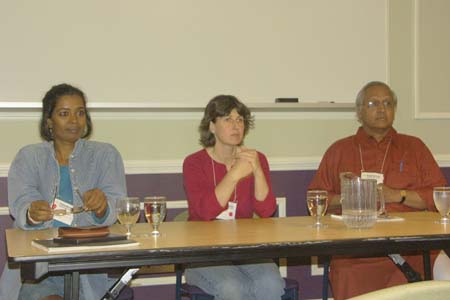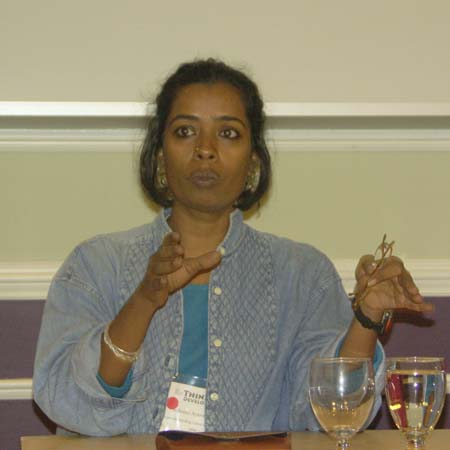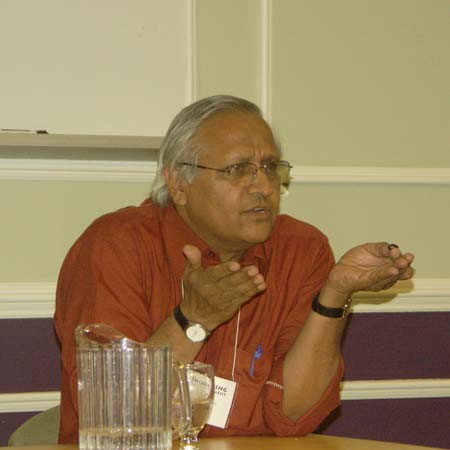
RETHINKING DEVELOPMENT
Local Pathways to Global Wellbeing
St. Francis Xavier University, Antigonish, Nova Scotia, Canada
June 20 to June 24, 2005
Sustainable Energy Use: Living off the Grid
Presenters:
Suhasini Ayer-Guigan, Auroville, India
Gael Watson, La Havre Bakery, Nova Scotia, Canada
Sanjit Bunker Roy, Barefoot Collge, India
Rapporteur: Kathleen Ives

- Development of an eco-city.
Vision – creating a city dedicated to human unity and international understanding
- Do away with property
- Unending education – constant and unending process – question everything
- Learn from the past, other cultures etc
- Site of material and spiritual research
Success Factors:
Key aspects in developing a sustainable settlement
- Environmental restoration – began in 1968 Auroville was started on barren plateau prone to erosion and dust storms only 10 days of rain a year
- Began first with land regeneration – tree planting, first for simple reasons to provide shade. Over years realized ground cover was needed to prevent erosion. They also introduced species that could withstand the conditions
- Organic and urban agriculture – dispensing with chemical fertilizer and pesticides, polyculture and crop rotation, use of manure, comp and mulch, use of legumes as manure etc
- Solar panel architecture – try to do away with electrical and mechanical needs of ventilation. Want natural daylight without the heat (tropical temperature is too high) so they try to create courtyards as cool air traps, creation of transition spaces for lowering the air temperature before it enters building, etc.
- Different kinds of building materials, different finishes
- Rainwater harvesting – building of swales, ponds etc
- Renewable energy – bio, wind and solar
There have been many challenges introducing this new way of living (.e.g establishing sewage recycling system, convincing locals that planting trees is a viable idea). The amount of rain fall in the area is also a challenge.

Gael has lived for 28 years without electricity in Nova Scotia, Canada. She and her husband built their house with products from barn and they reused shingles. For the first 18 years they lived without power of any sort then began using a propane fridge. They raised animals for food. They also realized they needed to live according to the climate – because the winters are cold in Canada they needed more protein in the winter and less in the summer. They have two solar panels for computer use, music, lights etc. They grow food in the garden, compost their waste and burn wood from their property.
In 1985 Gael started a bakery. She uses local, organic ingredients, and operates the bakery with people power. She uses the lessons she learned from living off the land to operate her bakery.
Mainstream Practice:
Most residents in the province consume tremendous amounts of resources from water, to electricity. Alternative Vision:
We do not have to consume as much as we do. Her lifestyle is far less expensive than the lifestyle of most Canadians. She believes people should reduce the amount they consume and revert back to nature.
Lessons Learned:
- Everyone should ask themselves, how much power do I need?
- We need to adjust as the climate changes
- Rain water harvesting stations – collecting rain water from roofs for the purpose of drinking
- Solar energy
- Digging wells to collect ground water
- Non electrified villages
- Villages and schools will have access to sweet water
- Villages will be solar energized
Barefoot approach is unique – first prepare the community
- First go to non-electrical village and introduce the idea of the new technology
- Second, take the most illiterate, unemployable person in the village and train them as an engineer at Barefoot College
- In 6 months, the person is a solar engineer
- Go back to village and implement solar technology
- Collect fees from villagers to pay for equipment and a stipend for the barefoot engineer
- Getting government to accept new technologies and change practices
- Recruiting women

Every building project is started with landscaping
Spend time in nature, see how well nature works to use less
A well goes into pressurized tank so there is pressurized water in the house.
Slow down the pace of life
Take care of your own children – stop giving them to other people to take care of
Urban agriculture
Holistic Land Management and Soil Health Restoration
Overview :: Presenters :: Proceedings :: Papers :: Home
Photography courtesy Patch of Blue by Stella McNeil.